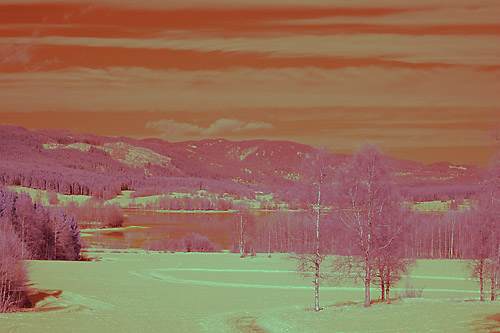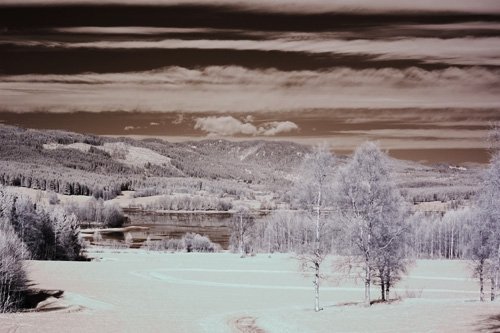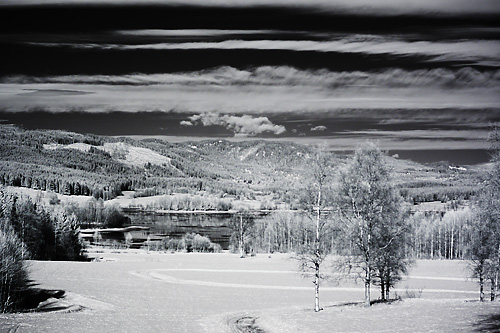 |
| Infrared
Landscape - Wratten 89B Nikon D70, Nikkor 50 mm f/2 lens, f/8 1/13 sec, 200 ISO equivalency, NEF format |
| Nikon D70 Digital Camera Reviewed | |
| by Bjørn Rørslett | |
6. Infrared (IR) photography with D70
One pleasant surprise with many of the digital cameras is their ability to record useful imagery outside the visible spectrum. Typically, the sensitivity to near-IR may be sufficiently high to allow IR photography not only in bright sunlight, but also under less well illuminated conditions. This is good news for any experimentally inclined end user, but bad news for the camera manufacturer.
The camera designers expressedly don't want IR to enter their cameras because IR will reduce perceived sharpness, make skies look washed out or experience colour shifts, produce blotched facial rendition, and visually increase the adverse impact of chromatic aberration (CA). Hence the ubiquitous occurence of an anti-IR filter in front of the imaging chip inside the camera, typically seen as a greenish sheen when the CCD/CMOS chip is exposed to light. The anti-IR filter is combined with an anti-aliasing (AA) filter in a filter pack, which may or may not be removable.
Each generation of Nikon D-series cameras has had its IR sensitivity decreased, or put the other way, the efficiency of the filter pack has increased. D70 has an IR sensitivity approximately on par with D2H, this implies it has nearly 2 EV less IR sensitivity than the D1-series models. This of course necessitates tripod use, but as far as I'm concerned, tripods are the normal means of mounting a camera anyway. No big deal.
Further test indicated however that D70, again similar to D2H, can be at least equally responsive to IR as D1H, for some special contingencies. Probably, this relates to the more gentle manner in which the internal IR filter rolls off its response toward longer wavelengths (see next paragraph). Incandescent lighting is just such a situation in which D70 may pick up more IR than you normally wish, and for which deployment of a hot-mirror filter may be a sensible cure.
 |
| Infrared
Landscape - Wratten 89B Nikon D70, Nikkor 50 mm f/2 lens, f/8 1/13 sec, 200 ISO equivalency, NEF format |
With the less dense Wratten 89B filter, the images lifted straight off the camera have a quite strong reddish cast to them. I would normally have tweaked the colour balance significantly, but in order to show the differences between various IR filter, I have tentatively left them in a pristine state. Hence the excessive reddish cast of the image displayed above.
 |
| Infrared
Landscape - Wratten 87 Nikon D70, Nikkor 50 mm f/2 lens, f/8 1 sec, 200 ISO equivalency, NEF format |
Wratten 87 is much denser than the 89B, and accordingly the exposure had to be increased by nearly 4 stops. Still the image came through beautifully so given the noise recution circuitry of D70 is switched on, you could do a bit of practical IR photography even with this virtually opaque filter.
 |
| Infrared
Landscape - Wratten 87C Nikon D70, Nikkor 50 mm f/2 lens, f/8 1.3 sec, 200 ISO equivalency, NEF format |
Quite unexpectedly, D70 responded nicely to the even darker Wratten 87C filter, and the main difference to the image obtained with Wratten 87 was a more muted and neutral colour balance, and a slightly enhanced feeling of depth to the landscape. Since the basic IR "look" is present already with a Wratten 89B or equivalent if you colour-balance the pictures, this approach should probably be the more wise to follow. D70 otherwise might run into longish exposures of sufficient duration to trigger troublesome hot pixels, if you choose to shot under less than bright sunlit conditions.
IR images obtained by D70 matched quite closely to those produced by my D2H, so in the future I can use either camera as a reliable backup to my customised D1 ("D1R") for professional digital IR photography.